engine coolant CADILLAC ESCALADE ESV 2011 User Guide
[x] Cancel search | Manufacturer: CADILLAC, Model Year: 2011, Model line: ESCALADE ESV, Model: CADILLAC ESCALADE ESV 2011Pages: 548, PDF Size: 8.45 MB
Page 409 of 548
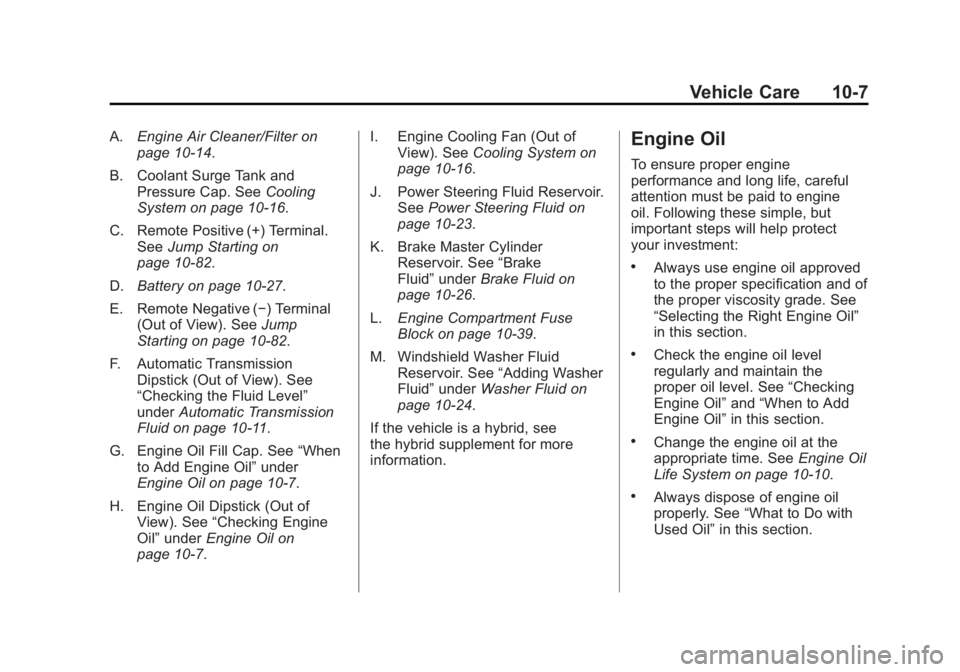
Black plate (7,1)Cadillac Escalade/Escalade ESV Owner Manual - 2011
Vehicle Care 10-7A. Engine Air Cleaner/Filter on
page 10 ‑ 14 .
B. Coolant Surge Tank and
Pressure Cap. See Cooling
System on page 10 ‑ 16 .
C. Remote Positive (+) Terminal.
See Jump Starting on
page 10 ‑ 82 .
D. Battery on page 10 ‑ 27 .
E. Remote Negative ( − ) Terminal
(Out of View). See Jump
Starting on page 10 ‑ 82 .
F. Automatic Transmission
Dipstick (Out of View). See
“ Checking the Fluid Level ”
under Automatic Transmission
Fluid on page 10 ‑ 11 .
G. Engine Oil Fill Cap. See “ When
to Add Engine Oil ” under
Engine Oil on page 10 ‑ 7 .
H. Engine Oil Dipstick (Out of
View). See “ Checking Engine
Oil ” under Engine Oil on
page 10 ‑ 7 . I. Engine Cooling Fan (Out of
View). See Cooling System on
page 10 ‑ 16 .
J. Power Steering Fluid Reservoir.
See Power Steering Fluid on
page 10 ‑ 23 .
K. Brake Master Cylinder
Reservoir. See “ Brake
Fluid ” under Brake Fluid on
page 10 ‑ 26 .
L. Engine Compartment Fuse
Block on page 10 ‑ 39 .
M. Windshield Washer Fluid
Reservoir. See “ Adding Washer
Fluid ” under Washer Fluid on
page 10 ‑ 24 .
If the vehicle is a hybrid, see
the hybrid supplement for more
information. Engine Oil To ensure proper engine
performance and long life, careful
attention must be paid to engine
oil. Following these simple, but
important steps will help protect
your investment: .
Always use engine oil approved
to the proper specification and of
the proper viscosity grade. See
“ Selecting the Right Engine Oil ”
in this section. .
Check the engine oil level
regularly and maintain the
proper oil level. See “ Checking
Engine Oil ” and “ When to Add
Engine Oil ” in this section. .
Change the engine oil at the
appropriate time. See Engine Oil
Life System on page 10 ‑ 10 . .
Always dispose of engine oil
properly. See “ What to Do with
Used Oil ” in this section.
Page 418 of 548
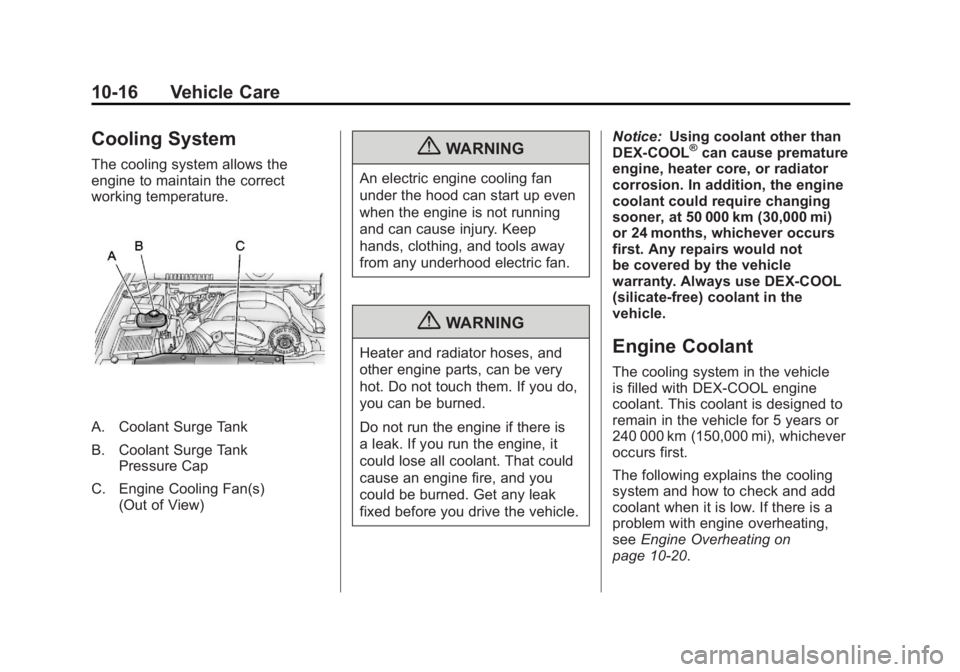
Black plate (16,1)Cadillac Escalade/Escalade ESV Owner Manual - 2011
10-16 Vehicle Care
Cooling System The cooling system allows the
engine to maintain the correct
working temperature.
A. Coolant Surge Tank
B. Coolant Surge Tank
Pressure Cap
C. Engine Cooling Fan(s)
(Out of View) { WARNINGAn electric engine cooling fan
under the hood can start up even
when the engine is not running
and can cause injury. Keep
hands, clothing, and tools away
from any underhood electric fan.
{ WARNINGHeater and radiator hoses, and
other engine parts, can be very
hot. Do not touch them. If you do,
you can be burned.
Do not run the engine if there is
a leak. If you run the engine, it
could lose all coolant. That could
cause an engine fire, and you
could be burned. Get any leak
fixed before you drive the vehicle. Notice: Using coolant other than
DEX-COOL ®
can cause premature
engine, heater core, or radiator
corrosion. In addition, the engine
coolant could require changing
sooner, at 50 000 km (30,000 mi)
or 24 months, whichever occurs
first. Any repairs would not
be covered by the vehicle
warranty. Always use DEX-COOL
(silicate-free) coolant in the
vehicle.
Engine Coolant The cooling system in the vehicle
is filled with DEX-COOL engine
coolant. This coolant is designed to
remain in the vehicle for 5 years or
240 000 km (150,000 mi), whichever
occurs first.
The following explains the cooling
system and how to check and add
coolant when it is low. If there is a
problem with engine overheating,
see Engine Overheating on
page 10 ‑ 20 .
Page 419 of 548
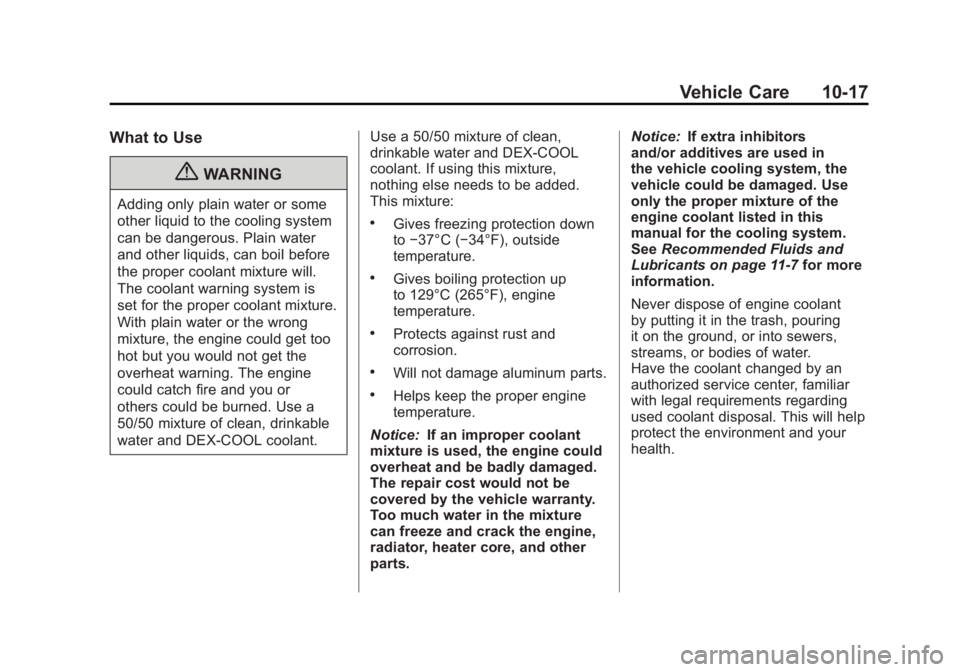
Black plate (17,1)Cadillac Escalade/Escalade ESV Owner Manual - 2011
Vehicle Care 10-17What to Use
{ WARNINGAdding only plain water or some
other liquid to the cooling system
can be dangerous. Plain water
and other liquids, can boil before
the proper coolant mixture will.
The coolant warning system is
set for the proper coolant mixture.
With plain water or the wrong
mixture, the engine could get too
hot but you would not get the
overheat warning. The engine
could catch fire and you or
others could be burned. Use a
50/50 mixture of clean, drinkable
water and DEX-COOL coolant. Use a 50/50 mixture of clean,
drinkable water and DEX-COOL
coolant. If using this mixture,
nothing else needs to be added.
This mixture: .
Gives freezing protection down
to − 37°C ( − 34°F), outside
temperature. .
Gives boiling protection up
to 129°C (265°F), engine
temperature. .
Protects against rust and
corrosion. .
Will not damage aluminum parts. .
Helps keep the proper engine
temperature.
Notice: If an improper coolant
mixture is used, the engine could
overheat and be badly damaged.
The repair cost would not be
covered by the vehicle warranty.
Too much water in the mixture
can freeze and crack the engine,
radiator, heater core, and other
parts. Notice: If extra inhibitors
and/or additives are used in
the vehicle cooling system, the
vehicle could be damaged. Use
only the proper mixture of the
engine coolant listed in this
manual for the cooling system.
See Recommended Fluids and
Lubricants on page 11 ‑ 7 for more
information.
Never dispose of engine coolant
by putting it in the trash, pouring
it on the ground, or into sewers,
streams, or bodies of water.
Have the coolant changed by an
authorized service center, familiar
with legal requirements regarding
used coolant disposal. This will help
protect the environment and your
health.
Page 420 of 548

Black plate (18,1)Cadillac Escalade/Escalade ESV Owner Manual - 2011
10-18 Vehicle Care Checking Coolant The vehicle must be on a level
surface when checking the coolant
level.
Check to see if coolant is visible in
the coolant surge tank. If the coolant
inside the coolant surge tank is
boiling, do not do anything else until
it cools down. If coolant is visible
but the coolant level is not at or
above the FULL COLD mark, add a
50/50 mixture of clean, drinkable
water and DEX-COOL coolant at the
coolant surge tank, but be sure the
cooling system is cool before this
is done. The coolant surge tank is located
in the engine compartment on the
passenger side of the vehicle. See
Engine Compartment Overview on
page 10 ‑ 6 for more information on
location.
The coolant level should be at or
above the FULL COLD mark. If it is
not, the vehicle may have a leak in
the cooling system. How to Add Coolant to the
Surge Tank
{ WARNINGYou can be burned if you spill
coolant on hot engine parts.
Coolant contains ethylene glycol
and it will burn if the engine parts
are hot enough. Do not spill
coolant on a hot engine.
Notice: This vehicle has a
specific coolant fill procedure.
Failure to follow this procedure
could cause the engine to
overheat and be severely
damaged.
{ WARNING
An electric engine cooling fan
under the hood can start up even
when the engine is not running
and can cause injury. Keep
hands, clothing, and tools away
from any underhood electric fan.
Page 422 of 548
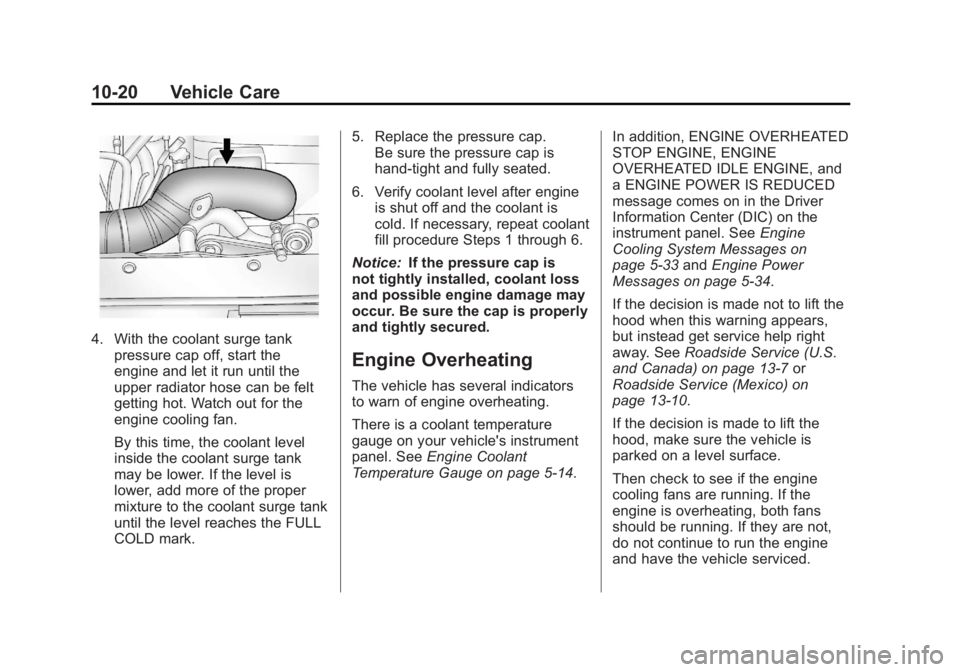
Black plate (20,1)Cadillac Escalade/Escalade ESV Owner Manual - 2011
10-20 Vehicle Care
4. With the coolant surge tank
pressure cap off, start the
engine and let it run until the
upper radiator hose can be felt
getting hot. Watch out for the
engine cooling fan.
By this time, the coolant level
inside the coolant surge tank
may be lower. If the level is
lower, add more of the proper
mixture to the coolant surge tank
until the level reaches the FULL
COLD mark. 5. Replace the pressure cap.
Be sure the pressure cap is
hand-tight and fully seated.
6. Verify coolant level after engine
is shut off and the coolant is
cold. If necessary, repeat coolant
fill procedure Steps 1 through 6.
Notice: If the pressure cap is
not tightly installed, coolant loss
and possible engine damage may
occur. Be sure the cap is properly
and tightly secured.
Engine Overheating The vehicle has several indicators
to warn of engine overheating.
There is a coolant temperature
gauge on your vehicle's instrument
panel. See Engine Coolant
Temperature Gauge on page 5 ‑ 14 . In addition, ENGINE OVERHEATED
STOP ENGINE, ENGINE
OVERHEATED IDLE ENGINE, and
a ENGINE POWER IS REDUCED
message comes on in the Driver
Information Center (DIC) on the
instrument panel. See Engine
Cooling System Messages on
page 5 ‑ 33 and Engine Power
Messages on page 5 ‑ 34 .
If the decision is made not to lift the
hood when this warning appears,
but instead get service help right
away. See Roadside Service (U.S.
and Canada) on page 13 ‑ 7 or
Roadside Service (Mexico) on
page 13 ‑ 10 .
If the decision is made to lift the
hood, make sure the vehicle is
parked on a level surface.
Then check to see if the engine
cooling fans are running. If the
engine is overheating, both fans
should be running. If they are not,
do not continue to run the engine
and have the vehicle serviced.
Page 423 of 548
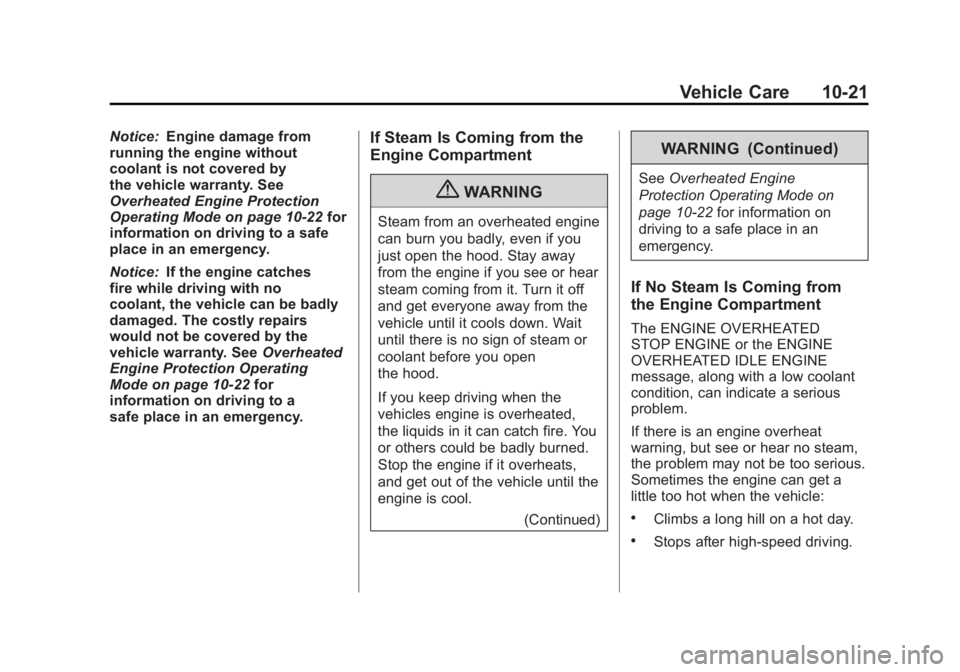
Black plate (21,1)Cadillac Escalade/Escalade ESV Owner Manual - 2011
Vehicle Care 10-21Notice: Engine damage from
running the engine without
coolant is not covered by
the vehicle warranty. See
Overheated Engine Protection
Operating Mode on page 10 ‑ 22 for
information on driving to a safe
place in an emergency.
Notice: If the engine catches
fire while driving with no
coolant, the vehicle can be badly
damaged. The costly repairs
would not be covered by the
vehicle warranty. See Overheated
Engine Protection Operating
Mode on page 10 ‑ 22 for
information on driving to a
safe place in an emergency. If Steam Is Coming from the
Engine Compartment
{ WARNINGSteam from an overheated engine
can burn you badly, even if you
just open the hood. Stay away
from the engine if you see or hear
steam coming from it. Turn it off
and get everyone away from the
vehicle until it cools down. Wait
until there is no sign of steam or
coolant before you open
the hood.
If you keep driving when the
vehicles engine is overheated,
the liquids in it can catch fire. You
or others could be badly burned.
Stop the engine if it overheats,
and get out of the vehicle until the
engine is cool.
(Continued) WARNING (Continued) See Overheated Engine
Protection Operating Mode on
page 10 ‑ 22 for information on
driving to a safe place in an
emergency.
If No Steam Is Coming from
the Engine Compartment The ENGINE OVERHEATED
STOP ENGINE or the ENGINE
OVERHEATED IDLE ENGINE
message, along with a low coolant
condition, can indicate a serious
problem.
If there is an engine overheat
warning, but see or hear no steam,
the problem may not be too serious.
Sometimes the engine can get a
little too hot when the vehicle: .
Climbs a long hill on a hot day. .
Stops after high-speed driving.
Page 424 of 548

Black plate (22,1)Cadillac Escalade/Escalade ESV Owner Manual - 2011
10-22 Vehicle Care .
Idles for long periods in traffic. .
Tows a trailer. See Trailer
Towing on page 9 ‑ 74 .
If the ENGINE OVERHEATED
STOP ENGINE or the ENGINE
OVERHEATED IDLE ENGINE
message appears with no sign of
steam, try this for a minute or so:
If the overheat warning is displayed
with no sign of steam:
1. Turn the air conditioning off.
2. Turn the heater on to the highest
temperature and to the highest
fan speed. Open the windows as
necessary.
3. In heavy traffic, let the engine
idle in N (Neutral) while stopped.
If it is safe to do so, pull off
the road, shift to P (Park)
or N (Neutral) and let the
engine idle.
If the temperature overheat gauge
is no longer in the overheat zone
or an overheat warning no longer
displays, the vehicle can be driven. Continue to drive the vehicle slowly
for about 10 minutes. Keep a safe
vehicle distance from the vehicle in
front. If the warning does not come
back on, continue to drive normally.
If the warning continues, pull
over, stop, and park the vehicle
right away.
If there is no sign of steam, idle
the engine for five minutes while
parked. If the warning is still
displayed, turn off the engine
until it cools down. Also, see
“ Overheated Engine Protection
Operating Mode ” later in this
section.
Overheated
Engine Protection
Operating Mode If an overheated engine condition
exists and the ENGINE POWER IS
REDUCED message is displayed,
an overheat protection mode which
alternates firing groups of cylinders
helps prevent engine damage. In this mode, a loss in power and
engine performance will be noticed.
This operating mode allows the
vehicle to be driven to a safe place
in an emergency. Driving extended
distances and/or towing a trailer in
the overheat protection mode
should be avoided.
Notice: After driving in the
overheated engine protection
operating mode, to avoid engine
damage, allow the engine to cool
before attempting any repair.
The engine oil will be severely
degraded. Repair the cause of
coolant loss, change the oil and
reset the oil life system. See
Engine Oil on page 10 ‑ 7 .
Engine Fan The vehicle has electric cooling
fans. The fans spinning at low
speed during most everyday
driving might be heard. The fans
can turn off if no cooling is required.
Page 426 of 548

Black plate (24,1)Cadillac Escalade/Escalade ESV Owner Manual - 2011
10-24 Vehicle Care
Washer Fluid What to Use When windshield washer fluid needs
to be added, be sure to read the
manufacturer's instructions before
use. Use a fluid that has sufficient
protection against freezing in an
area where the temperature may fall
below freezing.
Adding Washer Fluid The vehicle has a low washer fluid
message on the DIC that comes
on when the washer fluid is low.
The message is displayed for
15 seconds at the start of each
ignition cycle. When the WASHER
FLUID LOW ADD FLUID message
displays, washer fluid will need to
be added to the windshield washer
fluid reservoir. Open the cap with the washer
symbol on it. Add washer fluid
until the tank is full. See Engine
Compartment Overview on
page 10 ‑ 6 for reservoir location.
Notice .
When using concentrated
washer fluid, follow the
manufacturer's instructions
for adding water. .
Do not mix water with
ready-to-use washer fluid.
Water can cause the solution
to freeze and damage the
washer fluid tank and other
parts of the washer system.
Also, water does not clean as
well as washer fluid. .
Fill the washer fluid tank
only three-quarters full
when it is very cold. This
allows for fluid expansion
if freezing occurs, which
could damage the tank if it
is completely full. .
Do not use engine coolant
(antifreeze) in the windshield
washer. It can damage the
windshield washer system
and paint.
Brakes This vehicle has disc brakes. Disc
brake pads have built-in wear
indicators that make a high-pitched
warning sound when the brake pads
are worn and new pads are needed.
The sound can come and go or be
heard all the time the vehicle is
moving, except when applying the
brake pedal firmly.
Page 503 of 548
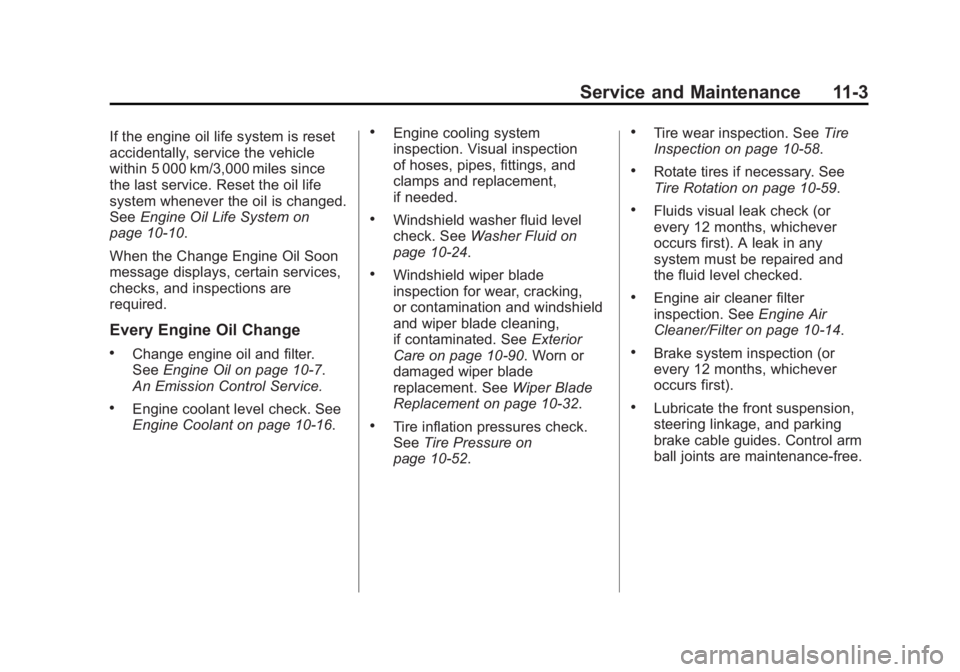
Black plate (3,1)Cadillac Escalade/Escalade ESV Owner Manual - 2011
Service and Maintenance 11-3If the engine oil life system is reset
accidentally, service the vehicle
within 5 000 km/3,000 miles since
the last service. Reset the oil life
system whenever the oil is changed.
See Engine Oil Life System on
page 10 ‑ 10 .
When the Change Engine Oil Soon
message displays, certain services,
checks, and inspections are
required.
Every Engine Oil Change .
Change engine oil and filter.
See Engine Oil on page 10 ‑ 7 .
An Emission Control Service. .
Engine coolant level check. See
Engine Coolant on page 10 ‑ 16 . .
Engine cooling system
inspection. Visual inspection
of hoses, pipes, fittings, and
clamps and replacement,
if needed. .
Windshield washer fluid level
check. See Washer Fluid on
page 10 ‑ 24 . .
Windshield wiper blade
inspection for wear, cracking,
or contamination and windshield
and wiper blade cleaning,
if contaminated. See Exterior
Care on page 10 ‑ 90 . Worn or
damaged wiper blade
replacement. See Wiper Blade
Replacement on page 10 ‑ 32 ..
Tire inflation pressures check.
See Tire Pressure on
page 10 ‑ 52 . .
Tire wear inspection. See Tire
Inspection on page 10 ‑ 58 . .
Rotate tires if necessary. See
Tire Rotation on page 10 ‑ 59 . .
Fluids visual leak check (or
every 12 months, whichever
occurs first). A leak in any
system must be repaired and
the fluid level checked. .
Engine air cleaner filter
inspection. See Engine Air
Cleaner/Filter on page 10 ‑ 14 . .
Brake system inspection (or
every 12 months, whichever
occurs first). .
Lubricate the front suspension,
steering linkage, and parking
brake cable guides. Control arm
ball joints are maintenance ‐ free.
Page 504 of 548
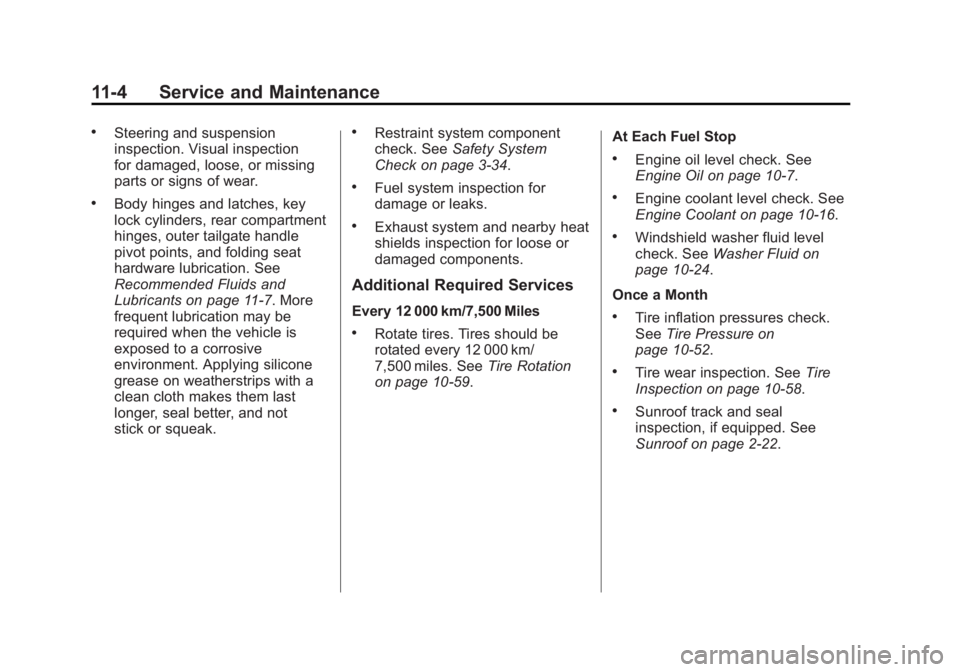
Black plate (4,1)Cadillac Escalade/Escalade ESV Owner Manual - 2011
11-4 Service and Maintenance .
Steering and suspension
inspection. Visual inspection
for damaged, loose, or missing
parts or signs of wear. .
Body hinges and latches, key
lock cylinders, rear compartment
hinges, outer tailgate handle
pivot points, and folding seat
hardware lubrication. See
Recommended Fluids and
Lubricants on page 11 ‑ 7 . More
frequent lubrication may be
required when the vehicle is
exposed to a corrosive
environment. Applying silicone
grease on weatherstrips with a
clean cloth makes them last
longer, seal better, and not
stick or squeak. .
Restraint system component
check. See Safety System
Check on page 3 ‑ 34 . .
Fuel system inspection for
damage or leaks. .
Exhaust system and nearby heat
shields inspection for loose or
damaged components.
Additional Required Services Every 12 000 km/7,500 Miles .
Rotate tires. Tires should be
rotated every 12 000 km/
7,500 miles. See Tire Rotation
on page 10 ‑ 59 . At Each Fuel Stop .
Engine oil level check. See
Engine Oil on page 10 ‑ 7 . .
Engine coolant level check. See
Engine Coolant on page 10 ‑ 16 . .
Windshield washer fluid level
check. See Washer Fluid on
page 10 ‑ 24 .
Once a Month .
Tire inflation pressures check.
See Tire Pressure on
page 10 ‑ 52 . .
Tire wear inspection. See Tire
Inspection on page 10 ‑ 58 . .
Sunroof track and seal
inspection, if equipped. See
Sunroof on page 2 ‑ 22 .